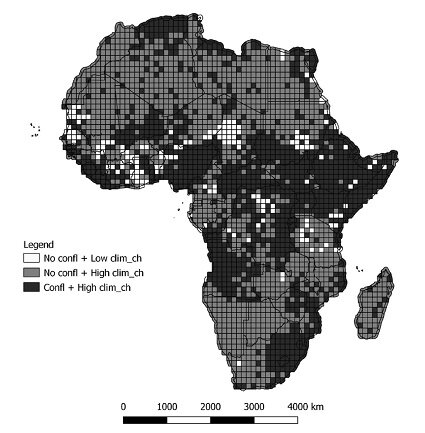Climate change affects the likelihood of armed conflict. Credit: UPV
Climate change influences the likelihood and duration of armed conflict in Africa. This is the conclusion of a study carried out by a team from the INGENIO Institute, a joint center of the Universitat Politècnica de València (UPV) and the Consejo Superior de Investigaciones Científicas (CSIC), in collaboration with the University of Rome. III and the University of Urbino Carlo Bo, published in the latest issue of the journal Political economics.
The team of researchers based their study on data from the African continent from 1990 to 2016. Using a negative binomial regression mathematical model, they assessed whether certain climatic phenomena, combined with the socio-economic characteristics of the areas studied, affected the likelihood of a conflict occurring and, if so, its duration.
Among its findings, the study indicates that a prolonged increase in temperature and rainfall increases the likelihood of conflict beyond the affected area by four to five times, especially in populations up to a radius of about 550km.
The study also concludes that in Africa, drought-induced food shortages increase the possibility of conflict, especially if water shortages persist for at least three years. Conversely, excessive rain triggers conflicts, but in a very short period of time.
Implications for adaptive policies
“The results we obtained have profound implications for territorial policies on the African continent. For example, changes in climatic conditions influence the likelihood of conflicts over large areas, which means that the design of adaptation policies to climate must take into account the particularities of each territory,” says Davide Consoli, researcher at the INGENIO Institute and one of the authors of the study.
The INGENIO, University of Rome and University of Urbino team also points out that the persistence of violence requires the implementation of climate change adaptation strategies designed in combination with peacekeeping measures, especially in the areas most prone to armed conflict.
“These measures are essential in the design and implementation of adaptation strategies for climate resilience. In fact, poorly designed adaptation interventions can exacerbate existing inequalities and increase the risk of conflict,” Consoli concludes.
Federica Cappelli et al, Climate Change and Armed Conflicts in Africa: Temporal Persistence, Nonlinear Climate Impact and Geographic Spillovers, Political economics (2022). DOI: 10.1007/s40888-022-00271-x
Provided by Universitat Politècnica de València
Quote: Climate change affects likelihood of armed conflict (2022, June 24) Retrieved June 24, 2022 from https://phys.org/news/2022-06-climate-affects-likelihood-armed-conflict.html
This document is subject to copyright. Except for fair use for purposes of private study or research, no part may be reproduced without written permission. The content is provided for information only.



